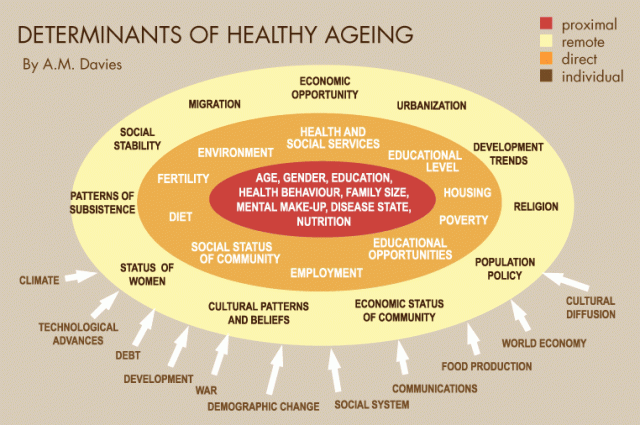Ageing and Health
When considering the potential importance of the geographical study of older people and populations, some basic facts are well worth remembering. Older people – typically defined by governments and other officialdom as being over 65 years of age – constitute a significant and growing proportion of the general populations of both developed and developing world counties; the former approximately 15%, the latter approximately 5% (but growing more rapidly). Although many characteristics, and activities of older people and populations are similar to other age groups, they also face unique circumstances and challenges. Older age is a stage of life associated with specific physical and psychological changes and states and, of all demographic groups, older people experience most health and mobility problems, are the greatest consumers of health and social care, and face a great deal of negative stereotyping and stigmatization. However, contrary to some popular beliefs, they also hold valuable positions in society and can, of course, live diverse, rich, and fulfilling lives. Given this scale and distinctiveness of aging related issues, human geography has long been, and continues to be, interested in studying older people in a variety of contexts from a variety of perspectives.

Broadly defined, the geography of aging (or what, in disciplinary terms is occasionally termed geographical gerontology) is concerned with the spatial characteristics and contexts of aging. These range from the distributive features of older populations, to the ways in which places reflect, older people and the ways in which places are experienced and negotiated by them. Not all of this field is focused on health issues and many studies consider wider social – and more recently cultural – aspects of older peoples' lives. However, concerns for health are evident in some form, and to some extent, in a substantial majority of studies in this field.
As a field of human geography, geographical studies of older people date back over 30 years and crosscut the interests of a number of subdisciplines including social geography, health geography, and more specialist varieties such as population geography and development geography. Not only have the empirical subjects studied mirrored the changing interests of these subdisciplines, but they have also changed in line with underlying paradigm shifts. As well as crosscutting various subdisciplines of human geography, geographical studies of aging have also drawn from, and contributed to, other recognizable bodies of research in human geography. For example, it is not unusual to see a particular geographical study of older people described as a welfare geography, a geography of caring, or an emotional geography. Notably, many studies are not identified explicitly as geographies of aging. This might be because the author does not consider the age of their subjects to be particularly important and/or the dimension he/she wishes to focus on.
With such a long standing and broad-based disciplinary history, and such a substantive body of work produced to date, it is perhaps surprising that geographies of aging do not posses a higher and more distinct profile in human geography (in comparison, for example, to children's geographies). To speculate, this might be due to the broad scope of the field. It arises right across human geography yet is not associated with, or essential to, any one single subdiscipline. Another reason might be because geographies of aging have generally followed or mirrored disciplinary progressions and innovations rather than forging them. A very different reason for a modest profile might simply be that, no matter how socially relevant and important aging is, it is not a particularly glamorous subject and indeed reminds all individuals – including geographers – of their own mortality. Indeed, despite four previous reports on the field published in Progress in Human Geography since 1980 the last – published in 1995 – is now rather dated.
Outside human geography, reflecting the global importance of aging and health and the academic attention it accords, geographies of aging have also made strong and sustained contributions to, and have also drawn from, other disciplines. Some of these are squarely aging focused such as clinical gerontology and social gerontology, while others are more general health categories such as epidemiology, demography, and various professionally focused research disciplines – including nursing and social work research – within which aging is one empirical interest among others. While adding variety to the field, this interdisciplinarity, has equally caused tensions among commentators. For example, while certain geographers have been eager for geographies of aging to draw on, contribute to, and reflect gerontology and the health sciences, others have been more concerned that con nections are strengthened with human and cultural geography.
Population Aging
Movements of Older Population
The Health of Older Populations
Negotiating Environments
Residence and Care
Emerging Critical Perspectives